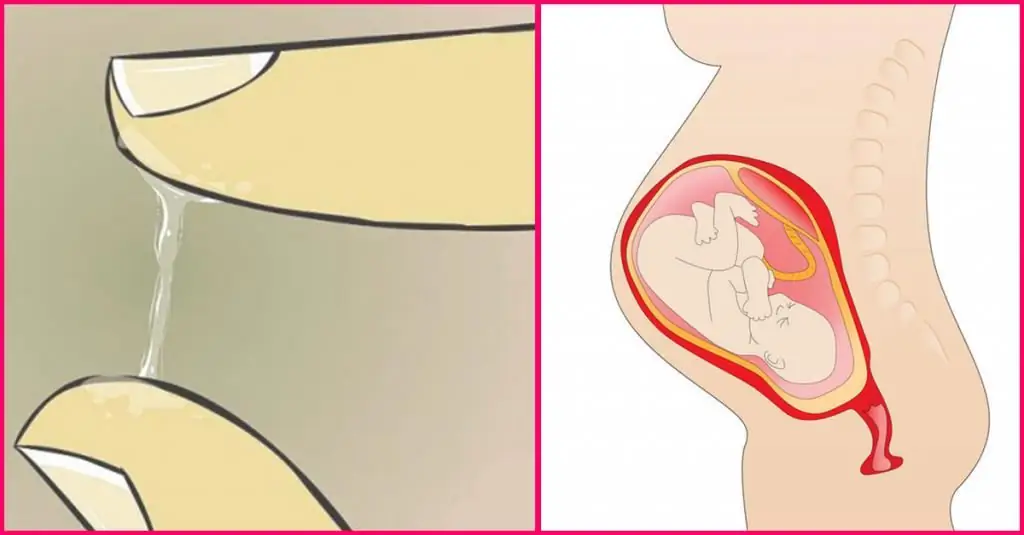2025 Author: Priscilla Miln | [email protected]. Last modified: 2025-01-22 17:55:27
While carrying a baby, a woman's body undergoes tremendous changes. Some of them remain invisible to others, while others are visible to the naked eye. The reproductive system is the first to signal the birth of a new life in a woman's body. About how breast changes occur during pregnancy, in the article. Consider what factors provoke their appearance and what symptoms should alert.
Causes of breast changes during pregnancy

From the moment of conception, changes begin to occur in a woman's body. Changes affect almost all systems: hormonal, genitourinary, reproductive, etc. In nature, everything is natural. That is why, simultaneously with the growth of the uterus, the mammary glands are being prepared for feeding the baby.
The main reason that causes breast changes duringPregnancy is hormones. There are several of them, and they all fulfill their role. The main hormone responsible for milk production during lactation is called prolactin. But progesterone, which affects the positive outcome of pregnancy in general, causes breast growth, an increase in the areola and prepares the glands for the natural feeding of the child. At the same time, oxytocin regulates the flow of milk into the breast ducts.
All these hormones cause during pregnancy the very changes that are necessary for successful lactation. That is why it is important to control their level while carrying a baby.
What do breasts look like during pregnancy at different times?

The main transformations that concern the mammary glands occur already in the first trimester of pregnancy. By the 10th to 14th week, for most women, symptoms such as itching and pain subside. We can say that at this stage the mammary glands have fully adapted to the first hormonal changes.
But this does not mean that breasts in early pregnancy and on the eve of childbirth look the same. As the abdomen grows, there is a further increase in the mammary glands, the areolas become darker, and the venous network is visible more and more clearly. Stretch marks may also appear if there is a predisposition to this. All these changes are the norm during the bearing of the crumbs.
Breast Augmentation During Pregnancy

Still a few more days before the test shows positiveresult, a woman can guess it herself. One of the first signs confirming the fact that conception has already occurred is the swelling and enlargement of the mammary glands.
The most noticeable breast growth occurs during the first 10 weeks and in the third trimester of pregnancy. This is explained by an increase in the volume of adipose tissue and blood flow to the mammary glands. For many women, breasts instantly increase by one size. And this happens only in the first two months of pregnancy. Large breasts are one of the hallmarks of an interesting position.
In general, during 40 weeks of pregnancy, the mammary glands increase by 1.5 - 2 sizes. They fill up, become heavier, because they hold more liquid. For most women, by the end of pregnancy, each breast weighs an average of 0.4 kg more than usual. At this time, it is important to purchase comfortable underwear that matches the new bust size.
Change sensitivity

Painful sensations in the mammary glands is another important sign of pregnancy. The chest hurts, as a rule, starting from the moment of conception and up to 12 - 14 weeks. This state is explained by the changes that occur with it. The chest swells, becomes heavier due to increased blood flow. Because of this, painful sensations arise in her.
Many women experience severe discomfort even from the slightest touch to the breast, it itches and itches. Some pregnant women are very sensitivenipples. For this reason, a doctor may advise a woman not to remove her bra, even while sleeping at night.
Darkening areolas
During pregnancy, changes in the breast affect not only the increase in its size, but also the color. We are talking about the darkening of the areola and nipples. Moreover, their size also changes. So, the nipples grow up to 1.2 cm in length, and the circumference of the halo reaches 5 cm. Thus, the nipples, as part of the mammary gland, are preparing for breastfeeding, and the darkened areolas signal to the child that this is where the source of nutrition is located. The same function is performed by the so-called Montgomery's glands located on the areola. When feeding, they emit a specific smell that is only noticeable by babies. That's why a newborn baby, who was placed on her mother's stomach immediately after birth, finds her breasts without difficulty.
In order to prepare the mammary glands for natural feeding, a woman is recommended to douse her breasts daily with water at room temperature, and from the second trimester to take a contrast shower.
Venous Mesh
Due to increased blood flow, many pregnant women may show veins. This sign is most often observed in thin, with thin white skin. The venous network becomes especially noticeable by the third trimester. There is no need to worry about this. When the pregnancy comes to its logical conclusion, everything will be out of place.
But the prevention of stretch marks should be taken care of in advance. To do this, increase the elasticity of the skin. If the chest itches during pregnancy, severe itching appears, this indicates stretching of the skin. At this time, it is especially important to pay attention to its hydration. For daily breast skin care, rubbing coconut or other neutral oils is recommended. Wheat germ oil is great.
Is it normal for nipple discharge during pregnancy?

Breast milk begins to be produced in sufficient volume only 2-3 days after birth. The first food of the baby is colostrum - a yellow liquid of a viscous consistency. It contains many more nutrients than mature milk, and therefore even a few drops are enough to make the baby full.
It is worth noting that colostrum does not appear after childbirth, but long before this event. By the end of the second or third trimester, a thick liquid begins to stand out from the nipples of a woman. This is the same colostrum. Usually it stands out a little, so the woman does not feel any discomfort. If wet spots are visible on the underwear, you can use special breast pads. They will protect outerwear from getting wet. You can buy them at a pharmacy or in a supermarket in the department with children's hygiene products.
Dangerous symptoms

In addition to the symptoms that are characteristic of all pregnant women, there are a number of symptoms that should alert a woman:
- chest pain is accompanied by unpleasant, pulling sensations in the lower partabdomen and bloody discharge from the vagina;
- a sharp deterioration in he alth, weakness;
- asymmetrical changes in the breast, when redness, bumps and depressions appear on one of the mammary glands.
If you experience one or more of the above symptoms, it is recommended that you seek immediate medical attention. Each of these signs can be a signal of premature termination of pregnancy or the beginning of an inflammatory process in the mammary glands.
Many women are frightened when, first during pregnancy, the breasts swelled, and then ceased to be sensitive, pain disappeared. This does not always indicate anembryony, but it is necessary to consult a doctor. As a rule, until the 8th week, breast sensitivity is always preserved.
What if there are no changes in the breast?

Thus, the mammary glands grow and change throughout pregnancy. But the strongest changes with them, accompanied by pain, itching and weighting, are observed in the first trimester. Breast tenderness decreases as the pregnancy progresses.
However, all the signs considered in this article are characteristic, but not mandatory. Their absence does not yet indicate pathological processes in the body. Since each body is individual, the changes in it for each woman can occur in different ways. For example, breasts may not swell during pregnancy because there is not enough room for them to grow. It is not uncommon for a woman to find out about conception by missing 2-3 periods. Moreover, no changes in her chest during this period did not bother her at all. Sensitivity and pain are purely individual, rather conditional signs of pregnancy.
Recommended:
What does a baby look like at 30 weeks pregnant: weight, dimensions, anatomy

At 30 weeks pregnant, every mom can't wait to meet her baby as soon as possible. The average weight of the crumbs at 30 obstetric weeks is about one and a half kilograms, and the length from the crown to the heels can reach up to 42 centimeters. At this time, the woman is waiting for maternity leave and a planned ultrasound
At what time does the chest start to hurt? Breast augmentation during pregnancy

Many women who become pregnant for the first time are interested in the question of how long the chest begins to hurt. There is no single answer to this question, since everything depends on the individual characteristics of the organism. Why do breasts hurt during pregnancy? At what time does this occur most often? How to remove or reduce discomfort in the chest?
What does a British cat look like and how long does it live?

Those who have ever seen a British cat turn into true fans of these graceful animals endowed with aristocratic habits. Representatives of this breed are distinguished by excellent he alth and outwardly resemble teddy bears. After reading today's article, you will find out how British cats look and how long they live
Cork during pregnancy: what does it look like and how does it go away?

During the formation of the embryo, many natural and unnatural physiological processes take place. For example, the absolute norm is the discharge of a cork during pregnancy. This article will talk about what it is, and why are all expectant mothers waiting for her to leave?
Does urine color change during pregnancy?

The color of urine during pregnancy is an important indicator of a woman's he alth. Its deviation from the norm always causes concern among expectant mothers. Find out why the color can change

